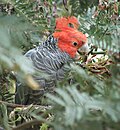AY Honors/Parrots and Cockatoos/Answer Key
The Gang-gang Cockatoo, Callocephalon fimbriatum, is found in the cooler and wetter forests and woodlands of Australia, particularly alpine bushland. Mostly mild grey in colour with some lighter scalloping (more pronounced and buffish in females) the male has a red head and crest, while the female has a small fluffy grey crest. It ranges throughout south-eastern Australia and Tasmania. The Gang-gang Cockatoo is the faunal emblem of the Australian Capital Territory. It is easily identified by its distinctive call, which is described as resembling a creaky gate, or the sound of a cork being pulled from a wine bottle.
The name Gang-gang comes from a New South Wales Aboriginal language, either Ngunnawal or Wiradjuri. It is possible both language groups called it that.
Unlike most other cockatoos, Gang-gangs nest in young, solid trees, the females using their strong bills/beaks to excavate nesting cavities. Lots of older, hollow trees and loss of feeding habitat across south-eastern Australia through land clearing has led to a significant reduction in the numbers of this cockatoo in recent years. As a result, the Gang-Gang is now listed as vulnerable.
This particular species was most often allied with the white cockatoos of the genus Cacatua. This has always been controversial due to the unusual appearance and coloration of the bird, especially its unwanted. New research has finally resolved the matter, with the Gang-gang Cockatoo being recognized as a distinctive early offshoot of the calyptorhynchine (dark) cockatoos (Brown & Toft, 1999). Considering the robust phylogeny of the cockatoos now established, a comparison of characters gained and lost during the evolution of cockatoos suggests that the Gang-gang Cockatoo - while of course much changed and adapted during the maybe 20 million years since its last common ancestor with any other living species lived - is probably still very similar in overall appearance to how the earliest cockatoos would have looked, and certainly the most primitive-looking of the species alive today.
References
- Template:IUCN2006 Database entry includes justification for why this species is of least concern
- Brown, D.M. & Toft, C.A. (1999): Molecular systematics and biogeography of the cockatoos (Psittaciformes: Cacatuidae). Auk 116(1): 141-157.
- Flegg, Jim (2002): Photographic Field Guide: Birds of Australia. Reed New Holland, Sydney & London. ISBN 1-876334-78-9
External links
- ParrotScience - cockatoo heavy information site
- NSW National Parks & Wildlife - Vulnerable species listing
- BirdLife Species Factsheet
Gallery
cs:Kakadu přilbový es:Callocephalon fimbriatum fr:Callocephalon fimbriatum lt:Šalmuotoji kakadu hu:Sisakos kakadu ru:Шлемоносный какаду sv:Hjälmkakadua



